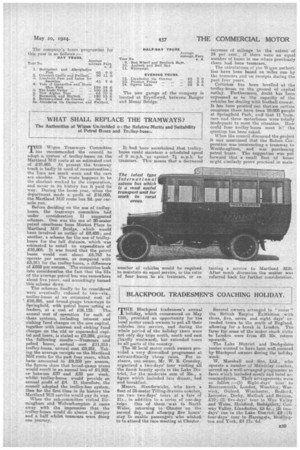WHAT SHALL REPLACE THE TRAMWAYS?
Page 23

If you've noticed an error in this article please click here to report it so we can fix it.
The Authorities at Wigan Unlecided o i the Relative Merits and Suitability of Petrol Bases and Trolley-buse.,.
THE Wigan Tramways Committee has recommended the council to adopt a system of trolley-buses on the Martland Mill route at an estimated cast of £10,805. At present the tramway track is badly in need ofreconstrnotion ; the lines are much worn and the cars are obsolete. The route happens to be the shortest worked by the corporation, and never in its history has it paid its way. During the boom year, when the department made a profit of £16,000, the Maitland Mill route lost 2d. per carmile run.
Before deciding on the use of trolleybuses, the tramways committee had under consideration 11 suggested schemes. One was the use of 20-seater petrol omnibuses from Market Place to Martland Mill Bridge, which would have involved an outlay of £8,420; and another, a scheme for the use of trolleybuses for the fell distance, which was estimated to entail an expenditure a £10,805. It was found that the petrol buses would cost about £6,763 to operate per annum, as compared with £5,911 for the trolley-buses, a difference of £852 per annum. The committee took into consideration the fact that the life of the average petrol bus was semewhere about five years, and accordingly turned this scheme down.
The schemes finally to be considered were eventually reduced to two—viz., trolley-buses at an estimated cost of £10,805, and broad-gauge tramways to Springfield, with petrol buses 'acting as
feeders, at a cost of £26,1. The-annual cost of operation for each of these systems, including interest and • sinking fund charges on the new capital, together with interest and sinking fund charges on the -old or superseded capital and loans, is stated as 22,229, giving the following results :—Thillleat'S and petrol buses, annual cost £11.215; trolley-buses, annual cost £9,251. Taking the average receipts on the Martland Mill route for the past. four years, which have amounted to £9,259 per annum, the figures show that broad-gauge trams would result in an annual loss of £1,952, cabetween PM and £38 per week, whilst trolley-buses would provide an annual profit of g4. If, therefore, the council adopted the trolley-bus system, then for the first time in its history the Martland Mill service would pay its way.
When the subcommittee visited Birmingham and Wolverhampton it came away With the impression that the trolley-buses would .do almost a journey and a half whilst tramcars were dMng one journey.
It had been ascertained that trolleybuses ,,crui d. maintain a scheduled speed of 9 m.p.h. -a.5 against 7* in:p.h. by tramcars. This means that a decreased
number of vehicles would be required to maintain an equal service, in the ratio of four buses to six tramcars, or an
increaseof mileage to the extent of 24 per cent., if there were an equal number of buses in use where previously there had been tramcars.
The calculations of the Wigan authorities have been based on miles run by the tramcars and on receipts during the past four years.
Criticism has been levelled at the trolley-buses on the ground of capital outlay. Furthermore, doubt has been expressed as to the capacity of the vehicles for dealing with football crowds. It has been pointed out that ion certain occasions there have been 20;000 people at Springfield Park, andt that 11 tramcars and three motorbuses were totally inadequate to meet the situation. How could four trolley-buses meet it? the question has been asked.
When the council discussed the project it was mentioned that the Bohm/ Corporation was constructing a tramway to Westhoughton, and was purchasing petrol buses. The suggestion was put forward that a small fleet of buses might similarly prove practical in main taming a service to Martland After mach discussion the matter was referred back for further consideration.






























